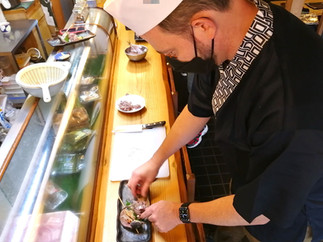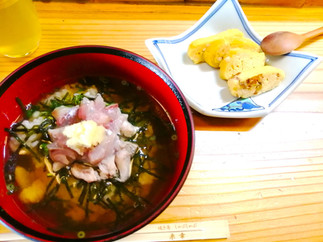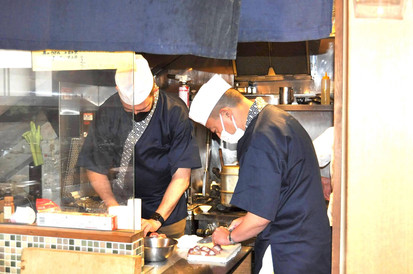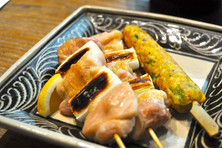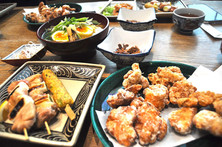Photo Report of Professional Yakitori Course April 2022
- secretaryoffice
- May 27, 2022
- 4 min read
After being suspended due to the COVID19 disaster, JCI's professional Yakitori lessons have resumed for the first time in almost two years!
We, the entire staff, have been looking forward to this day for a long time!
Here is a report on the Yakitori lesson with two students who live in Japan and are also cooking fanatics of cooking!
This Yakitori course will be a 5-day session (1 day for lecture and introduction and four days for practical onsite lessons).
Day 1: Orientation and lecture on Yakitori.
Day 2: Much hands-on training at different yakitori restaurants with different concepts.
Students were taught directly by the master onsite at a Yakitori restaurant on the first day at the Yakitori restaurant. Things are already heating up in the kitchen!
Preparation&Kushi-uchi(skewering): Chicken is a delicate food, and freshness is crucial. Careful preparation of chicken is critical. Preparation is the skill of a professional, and we learn it well. The one thing that both lessons have in common is that freshness is crucial for Yakitori. Chicken must be purchased as fresh as possible at a specialty poultry store, and after it is cut in the morning, it is prepped and prepared on the same day to not spoil the flavor of the flesh itself.
Salting: Grilled chicken is all about shaking salt! See, the students look like Yakitori shop owners in their salt-swinging posture. How cool is that!
Grilling: Students learn how to start a fire, adjust the flame, and learn grilling techniques. These adjustments determine whether the chicken will be crispy on the outside, fluffy and juicy inside, with a deep flavor. Practice to perfection! There is only repetitive practice!
Day 3: Lectures on buying techniques, food knowledge, and practical handson lesson.
JCI's Yakitori chef's uniforms finally arrived! The delivery was significantly delayed due to the COVID19. The Students in uniform look great!
At the store, students started preparing the vegetable skewers. Cooking and tasting, today they seasoned all the vegetable skewers and asparagus wrapped with pork with salt. The master dared not use the Tare(dipping sauce) to memorize the primary taste, the taste of the ingredients themselves, on the tongue.
Even the name "Yakitori" does not mean that only chicken is used. Pork, beef, and many kinds of vegetables are also skewered and grilled. Today, in addition to the different types of yakitori, students also learned about many kinds of pork yakitori. Tongue, heart, and all are cut, skewered, seasoned, and grilled differently. It is a showcase of professional skills.
Lunch on the second day was horse mackerel tataki. It was the first time for the students to take down a fish. They were pretty nervous. But once they master the basics, they will be able to handle a variety of fish. Have you managed to fillet the fish into three pieces: the head, bones, and tail as one part, the right and the left side of the body? This is called "Sanmai-oroshi(there piece filleting)." It means to cut the fish into three thin slices.
Once the fish is done, they lightly pound the meat with a knife to make it into a coarse mince to be easy to eat. All that remains is to garnish it with the backbone with the head attached and the condiments of green shiso, ginger, green onion, and voila! Pair that with shellfish miso soup and some white rice, and you have a traditional Japanese meal!
After the lesson, students visited Odawara Castle. The day was challenging with shopping, cooking, exploring history, and eating. It was a day of hard work for all of us.
Day 4: Preparing yakitori sauce and training for grilling
For morning shopping, the students took a long trip to a market and stocked up on fresh ingredients while receiving lectures on such things as Japanese garlic, which is the key ingredient in the sauce.
The lesson began with the preparation of the long-awaited Yakitori sauce, Tare. It is made by blending soy sauce, sake, mirin(cooking sake), garlic, and other ingredients. The white meat and liver prepared on the second day of the lesson were all grilled. They compared the taste of the grilled chicken with the sauce we prepared today and the chicken with the sauce that the teacher has been making for 40 years.
While the sauce was simmering, we made "Magocha" using horse mackerel for lunch on the fourth day. Magocha is a type of Chazuke with horse mackerel as a topping, but this time dashi is used instead of green tea. This time, instead of green tea, dashi was used. This was the second time preparing the horse mackerel, and the students seemed to be getting used to it. At the request of one of the students, they also tried their hand to make a Japanese-style rolled egg omelet.
This in-store lesson taught the students the professional skills of a Yakitori chef who handles chicken and vegetables and pork. Students also learned how to identify ingredients such as fish and vegetables through shopping. In making lunch, they learned basic fish processing, boiling, making dashi (Japanese soup stock), and even how to make Japanese-style omelets.
Day 5: Chichen Kaiseki Course cooking at Kappo Restaurant in Tokyo!
Meanwhile, on the last day of the Yakitori course, students made a Kaiseki course using chicken as the main ingredient at a Kappo (upscale Japanese home cooking restaurant). They learned techniques directly from a professional Washoku chef.
The menus are 1)Karaage(Japanese style fried chicken with three flavors), Chicken gizzards in olive oil and soy sauce, Tsukune and Negima, and Chicken ramen topped with lemon-flavored steamed chicken. How gorgeous is that!
As for the Tsukune, the minced chicken is kneaded together with aromatic vegetables and other ingredients until it becomes sticky. Then, egg whites are whipped to a stiff creamy consistency and quickly mixed in to make the texture fluffy. It is the chef’s secret recipe. After forming and steaming, grill them to a golden brown to make a juicy Tsukune.
The master chef and students enjoyed all the chicken dishes together, and after many hours of training in the kitchen and visits at the end of the course, students got the course certificate.
Yakitori is so popular worldwide. There are many other professional secrets to Yakitori preparation and cooking, so create your secret recipe with JCI's Yakitori Course.
JCI professors will help you.
For more information about JCI's Yakitori Course, click the link.













